
The Eurasian crag martin or just crag martin is a small passerine bird in the swallow family. It is about 14 cm (5.5 in) long with ash-brown upperparts and paler underparts, and a short, square tail that has distinctive white patches on most of its feathers. It breeds in the mountains of southern Europe, northwestern Africa and across the Palearctic. It can be confused with the three other species in its genus, but is larger with brighter tail spots and different plumage tone. Many European birds are resident, but some northern populations and most Asian breeders are migratory, wintering in northern Africa, the Middle East or India.

Brachychiton rupestris is a tree in the family Malvaceae, endemic to Queensland, Australia. Described by Sir Thomas Mitchell and John Lindley in 1848, it earned its name from its bulbous trunk, which can be up to 3.5 metres (11 ft) in diameter at breast height (DBH). Reaching around 10–25 metres (33–82 ft) high, the Queensland bottle tree is deciduous, losing its leaves seasonally, between September and December. The leaves are simple or divided, with one or more narrow leaf blades up to 11 centimetres (4 in) long and 2 centimetres (0.8 in) wide. Cream-coloured flowers appear from September to November, and are followed by woody, boat-shaped follicles that ripen from November to May. No subspecies are recognised.

Macrourus is a small benthopelagic genus of rattails from the family Macrouridae.
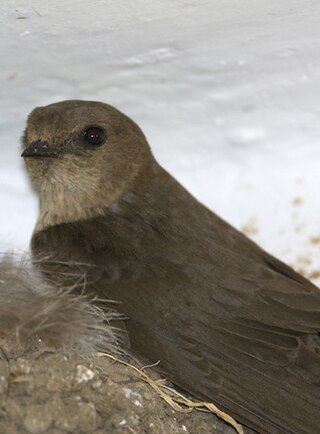
The crag martins are four species of small passerine birds in the genus Ptyonoprogne of the swallow family. They are the Eurasian crag martin (P. rupestris), the pale crag martin (P. obsoleta), the rock martin (P. fuligula) and the dusky crag martin (P. concolor). They are closely related to each other, and have formerly sometimes been considered to be one species. They are closely related to the Hirundo barn swallows and are placed in that genus by some authorities. These are small swallows with brown upperparts, paler underparts without a breast band, and a square tail with white patches. They can be distinguished from each other on size, the colour shade of the upperparts and underparts, and minor plumage details like throat colour. They resemble the sand martin, but are darker below, and lack a breast band.

Trentepohlia is a genus of filamentous chlorophyte green algae in the family Trentepohliaceae, living free on terrestrial supports such as tree trunks and wet rocks or symbiotically in lichens. The filaments of Trentepohlia have a strong orange colour caused by the presence of large quantities of carotenoid pigments which mask the green of the chlorophyll.

Capnodiales is a diverse order of Dothideomycetes, initially based on the family Capnodiaceae, also known as sooty mold fungi. Sooty molds grow as epiphytes, forming masses of black cells on plant leaves and are often associated with the honeydew secreted by insects feeding on plant sap. This diverse order has been expanded by the addition of several families formerly thought unrelated and now also includes saprobes, endophytes, plant pathogens, lichens and rock-inhabiting fungi. The new additions include the genus Mycosphaerella containing the causal agents of several economically important crop and tree diseases. A small number of these fungi are also able to parasitise humans and animals, including species able to colonise human hair shafts.

Verrucariaceae is a family of lichens and a few non-lichenised fungi in the order Verrucariales. The lichens have a wide variety of thallus forms, from crustose (crust-like) to foliose (bushy) and squamulose (scaly). Most of them grow on land, some in freshwater and a few in the sea. Many are free-living but there are some species that are parasites on other lichens, while one marine species always lives together with a leafy green alga.

Caloplaca is a lichen genus comprising a number of distinct species. Members of the genus are commonly called firedot lichen, jewel lichen. gold lichens, "orange lichens", but they are not always orange, as in the case of C. albovariegata. The distribution of this lichen genus is worldwide, extending from Antarctica to the high Arctic. It includes a portion of northern North America and the Russian High Arctic. There are about thirty species of Caloplaca in the flora of the British Isles.
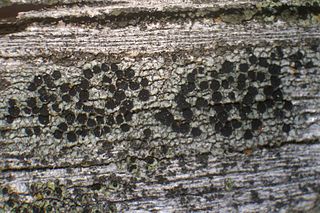
Buellia is a genus of mostly lichen-forming fungi in the family Caliciaceae. The fungi are usually part of a crustose lichen. In this case, the lichen species is given the same name as the fungus. But members may also grow as parasites on lichens (lichenicolous). The algae in the lichen is always a member of the genus Trebouxia.

Opegrapha is a genus of lichenized fungi in the family Opegraphaceae. Species include:

Verrucaria is a genus of lichenized (lichen-forming) fungi in the family Verrucariaceae.
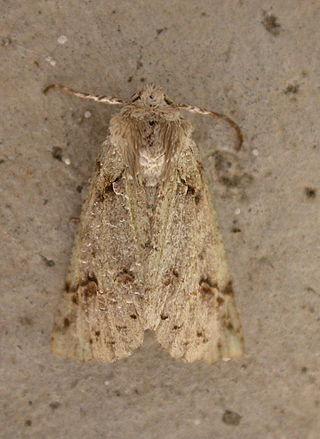
Declana is a genus of moths in the family Geometridae that is endemic to New Zealand. The genus was erected by Francis Walker in 1858.
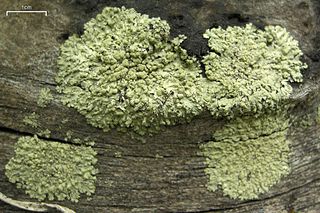
Parmeliopsis is a genus of lichens in the family Parmeliaceae. The genus contains two species. Members of this genus are commonly called bran lichens.
Oligoryzomys rupestris is a species of rodent in the genus Oligoryzomys of family Cricetidae. It is known only from eastern Brazil, where it has been found in several localities in the campos rupestres montane savanna ecoregion. This is a small Oligoryzomys species with a gray head, a yellow-brown back and gray belly and tail. Of the two karyotypic forms described by Silva & Yonenaga-Yassuda in 1998, species 1 is probably identical to O. rupestris, while the other is closely related. Its karyotype has 2n = 46 and FNa = 52.
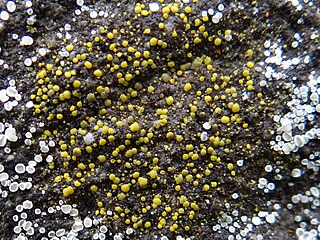
Protoblastenia is a genus of lichens in the family Psoraceae. It was originally circumscribed by Alexander Zahlbruckner in 1908 as a section of genus Blastenia. J. Steiner promoted it to generic status in 1911.

Lichens are symbiotic organisms made up of multiple species: a fungus, one or more photobionts and sometimes a yeast. They are regularly grouped by their external appearance – a characteristic known as their growth form. This form, which is based on the appearance of vegetative part of the lichen, varies depending on the species and the environmental conditions it faces. Those who study lichens (lichenologists) have described a dozen of these forms: areolate, byssoid, calicioid, cladoniform, crustose, filamentous, foliose, fruticose, gelatinous, leprose, placoidioid and squamulose. Traditionally, crustose (flat), foliose (leafy) and fruticose (shrubby) are considered to be the three main forms. In addition to these more formalised, traditional growth types, there are a handful of informal types named for their resemblance to the lichens of specific genera. These include alectorioid, catapyrenioid, cetrarioid, hypogymnioid, parmelioid and usneoid.

Mycoblastus is a genus of crustose lichens in the family Tephromelataceae. Members of the genus are commonly called blood lichens.

Baeomyces is a genus of lichenized fungi in the family Baeomycetaceae. Members of Baeomyces are commonly called cap lichens. The genus was circumscribed by German mycologist Christiaan Hendrik Persoon in 1794. Although Persoon did not designate a type species in his original description of the genus, Frederick Clements and Cornelius Lott Shear assigned Baeomyces byssoides as the type in 1931.
Gintaras Kantvilas is an Australian lichenologist, who earned his Ph.D in 1985 from the University of Tasmania with a thesis entitled Studies on Tasmanian rainforest lichens. He has authored over 432 species names, and 167 genera in the field of mycology.















